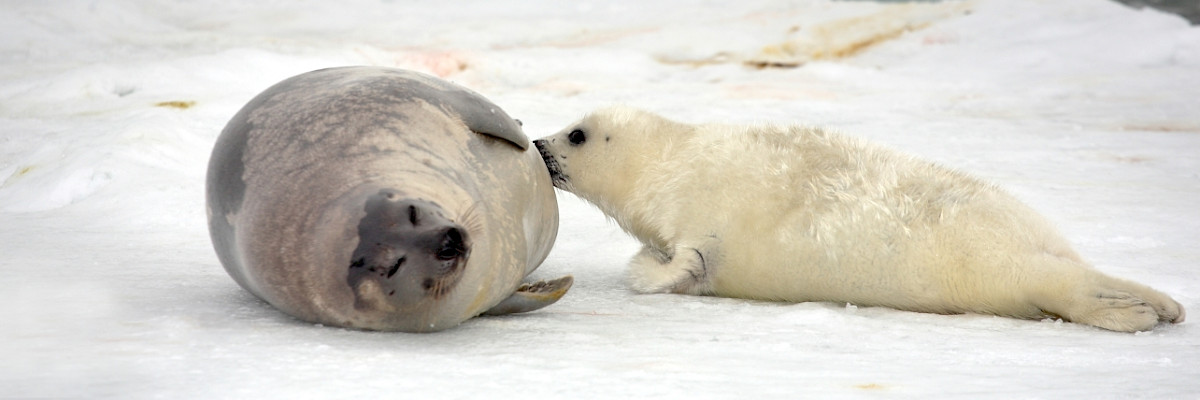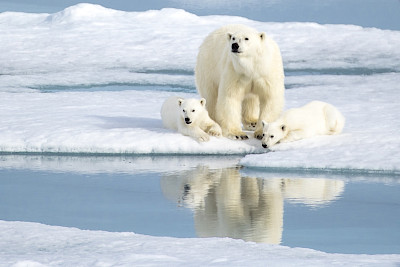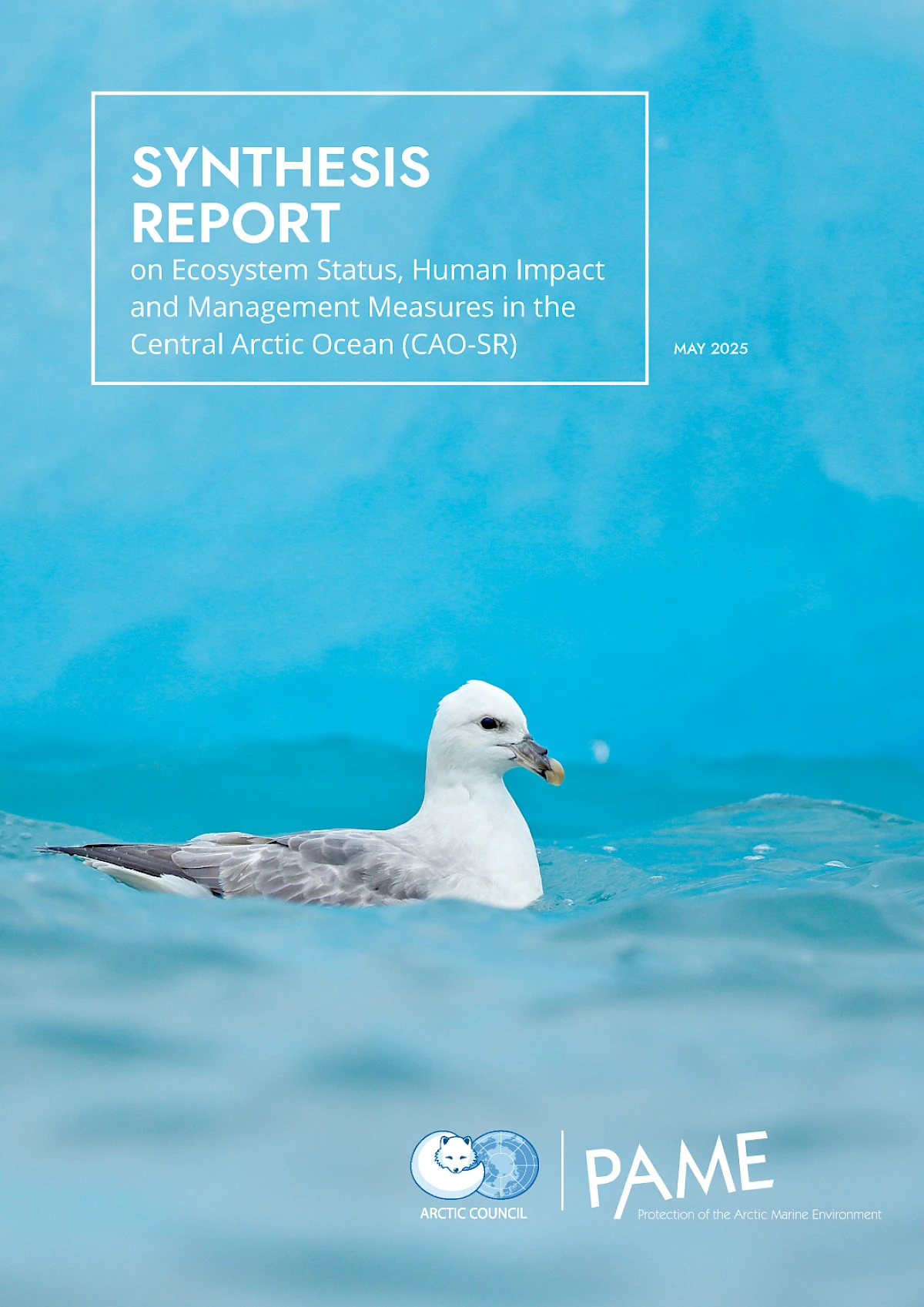
The Central Arctic Ocean - Ecosystem status, human impact and management measures
The Central Arctic Ocean (CAO) has historically been an area completely covered by multi-year sea ice and largely inaccessible. Due to climate change, the summer ice in the CAO is rapidly disappearing, with some recent modelling studies indicating that the Arctic Ocean could be virtually free of sea ice in September before 2050, “…irrespective of emission scenarios”.
The impending accessibility of large parts of the CAO to human activities has driven several initiatives in the Arctic Council, some of which are noted below. The ecological adjustments driven by a change from stable multi-year ice to an area that is seasonally ice-free will also likely have impacts at local, national, regional, and global levels. There is already evidence that some species are moving northward, and that the composition of parts of the food web is changing. Such changes, and especially human pressures, are likely to affect the status of the ecosystem and its need for protection of the marine environment. With the rapid change that is occurring, it is timely to gather the range of existing information on this area to inform effective future policy and decision making.
History and purpose of the report
There have been several references in Arctic Council work to the importance of understanding current and future conditions in the CAO, including the use of such understanding in informing the Agreement to Prevent Unregulated High Seas Fisheries in the Central Arctic Ocean, which entered into force in 2021.
Recognizing the importance of understanding the current and future state of the marine ecosystem in the CAO, Arctic Council Ministers adopted the 2021 Arctic Council Strategic Plan that outlined the goal of, “Synthesizing relevant information on the status, trends and projected changes in the Central Arctic Ocean, human activities and pressures in the area, and the current management measures in place in order to inform future policy and decision making.” Led by the Arctic Council's Protection of the Arctic Marine Environment (PAME) Working Group, the CAO-SR undertakes to respond to the above goal, with the express purpose of synthesizing existing information in order to inform future decisions around the Central Arctic Ocean.
The report is situated in the context of Arctic Council initiatives and other relevant international processes and instruments. PAME’s Framework for a Pan-Arctic Network of Marine Protected Areas sets out the vision for an “ecologically connected, representative and effectively managed network of protected and specially managed areas”.
How the CAO might be included or represented in this work is not yet known, but the newly adopted Agreement under the United Nations Convention on the Law of the Sea on the conservation and sustainable use of marine biological diversity of areas beyond national jurisdiction provides a mechanism for the establishment of area-based management tools including marine protected areas.
The report could also help to inform responses to a number of strategic actions under the Arctic Council’s Arctic Marine Strategic Plan 2015-2025, including:
- Promote the implementation of the ecosystem approach to management in the Arctic through synthesis and application of the results of relevant work by the Arctic Council and associated efforts by relevant organizations.
- Identify and assess threats and impacts to areas of heightened ecological and cultural significance and how such areas may be influenced in the future by climate change and other human induced changes and activities.
- Encourage the Arctic states to implement appropriate measures, or to pursue such measures at relevant international organizations to protect Arctic marine Areas of Heightened Ecological and Cultural Significance. Focus should be on species and ecosystems particularly at risk from climate change and cumulative impacts, including areas of refuge for ice-associated species that are, or are expected to become particularly important to Arctic marine biodiversity under future climate conditions.
- Develop a pan-Arctic network of marine protected areas, based on the best available knowledge, to strengthen marine ecosystem resilience and contribute to human wellbeing, including traditional ways of life.
REPORT OBJECTIVES
- Understand and describe management measures for the CAO;
- Assess current human activities, their drivers and pressures in the CAO;
- Highlight the common understanding on the state of biodiversity and ecosystems, trends and projected changes in the CAO;
- Bring together and synthesize information to inform policy makers on future marine conservation needs in the CAO in order to enable cooperative adaptive ecosystem-based management;
- Communicate information on Indigenous Peoples’ Knowledge and local knowledge, and Indigenous interests in the context of the high seas, in particular the CAO;
- Initiate collaboration with the International Council for the Exploration of the Seas (ICES)/ North Pacific Marine Science Organization (PICES)/PAME Working Group on Integrated Ecosystem Assessment for the Central Arctic Ocean (WGICA), the Circumpolar Biodiversity Monitoring Program (CBMP) of the Arctic Council Working Group for the Conservation of Arctic Flora and Fauna (CAFF), and the cross-working group Ecosystem Approach Expert Group to enhance the efforts to complete an Ecosystem Overview for the CAO, as a basis for any future ecosystem based management; and,
- Collaborate with the Scientific Coordinating Group (SCG) created under the Agreement to Prevent Unregulated High Seas Fisheries in the CAO in their efforts to develop a Joint Program of Scientific Research and Monitoring.

The Agreement to Prevent Unregulated High Seas Fisheries in the Central Arctic Ocean (CAOFA) includes a requirement for the Parties to establish a Joint Program of Scientific Research and Monitoring (JPSRM). The framework of the JPSRM was established by the Conference of the Parties (COP) in June 2023, and the Implementation Plan of the JPSRM was adopted by the COP in June 2024. The CAO-SR has gathered information that may be of use in the implementation of the JPSRM as it takes into account research gaps to support the effective implementation of the agreement. This report is not the only effort to consolidate information on the CAO. It builds on and complements work that has been done through the WGICA. This working group focuses specifically on relevant information and methods for integrated ecosystem assessments. Much work has been completed through the WGICA to report on the status of the CAO ecosystem, including the physical and biological components. The WGICA is now producing a report on the human activities, pressures, and impacts on the ecosystems of the CAO, and is developing a climate and vulnerability assessment of the area.
REPORT SCOPE
The report chapters cover the CAO large marine ecosystem (LME), as adopted by the Arctic Council Ministerial Meeting in 2013, based on earlier work by the PAME working group. The exception to the report’s scope comes in chapter three, the chapter on governance, which covers the portion of the CAO that is beyond national jurisdiction. The map shows the overlap between these two designations.
Chapter three takes on a different scope because the authors chose not to do an assessment of the national governance measures that could apply to portions of the LME, focusing instead on international measures. There are also places in some other chapters where references are made to data or measures that do not exactly align with the LME. Data is not always conveniently gathered according to the Arctic LME designations and can be difficult to disaggregate. Where this occurs, it will be noted in the text.

 Arctic Council Working Group
Arctic Council Working Group 